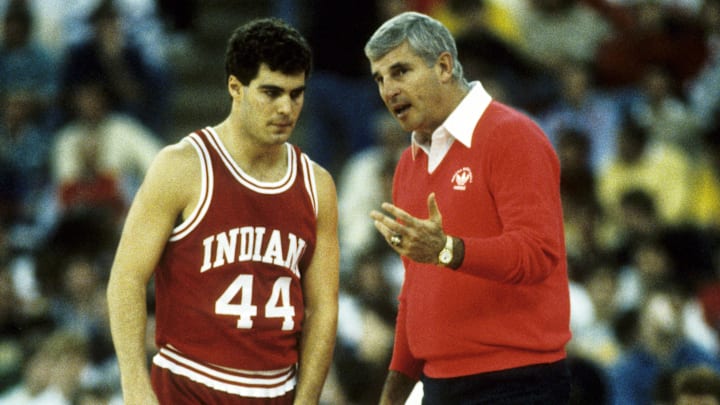College basketball once occupied one of the most prominent places in the American sporting consciousness, even hovering above the NBA in the heyday of the old Big East. Now, it seems the sport can only hold the national spotlight for a few weeks every spring, burning hot and bright and mad, but only for a short time.
Yet, while those days when college hoops reigned supreme might be gone, Mark Mehler and Jeff Tiberi are looking to ensure that they’re not forgotten.
“A poet once said, ‘American, thy name should be amnesia” Mehler said when discussing their new book, The Magnificent Seven: College Basketball’s Blue Bloods. “I think there are a lot of college basketball fans who really don’t know the history.”
So what makes a college basketball blue blood?
Mehler and Tiberi’s book focuses on the seven college basketball programs that they deem to be “blue bloods” based on their particular criteria. Duke, Indiana, Kansas, Kentucky, North Carolina, UCLA, and UConn.
There are constant arguments over which programs are the true "blue bloods" but the designation and subsequently the arguments are so nebulous and subjective that it becomes impossible to pin down. How can UConn be a "blue blood" if all the programs titles have come since 1999? Why doesn't Villanova deserve a spot at the table for its history in the Big East under Rollie Massimino? Does Indiana still belong without if its last title came in 1987?
Well, to make it easy, Mehler and Tiberi laid out clear objective ground rules for inclusion in The Magnificent Seven:
"You had to have won at least four (national) titles, and to have done so over a period of at least three decades," Mehler succinctly explained. "And those are the seven that have."
The co-authors removed the subjectivity from the argument and boiled it down to sustained success. And with the stat that Mehler shared, you're almost forced to agree that these are the seven most important programs in the history of the sport. "Over the last 40 years, there have only been two seasons where at least one of the blue bloods was not in the Final Four."
But in a sporting ecosystem with such short memories, does blood run blue forever?
Replacing legends: The post-Wooden and post-Knight challenges
Sustained success is what differentiates a Duke, which has seamlessly transitioned from Coach K to Jon Scheyer, or North Carolina, which went from Dean Smith to Roy Williams with only six seasons in between, from a Florida, which won its first championship since Billy Donovan left for the NBA, or even Villanova which is hoping that Kevin Willard with be the answer post-Jay Wright.
It’s never easy replacing a legendary coach, as Mehler and Tiberi explore throughout different chapters of the book, particularly with UCLA and Indiana. So, what does it mean if you get it wrong?
“It’s always tough,” Mehler said, attempting to decide which program had the most difficult time finding a successor. “In UCLA’s case, it was the most brutal. I can say that. I don’t think anybody ever had it worse than Gene Bartow,” who ultimately took over the Bruins in 1975 following Wooden’s 10th and final national championship.
UCLA has a recent trip to the Final Four in 2021 under Mick Cronin, and has won a National Championship in the post-John Wooden era (in 1995 under Jim Harrick), but it’s been a while since the Bruins have felt like a national powerhouse, and LA has been the epicenter of college basketball. Yet, because of Wooden's dominance and his elevated status as a true legend of the sport, no matter if the group grows to the magnificent eight, nine or 10, UCLA always deserves a seat at the table.
Indiana, on the other hand, still meets the qualifications as a true blue blood, but the Hoosiers are testing the bounds of historical success. Since Bobby Knight’s final season, the Hoosiers have missed the NCAA Tournament 13 times and made it only 12 times. Indiana made the National Championship Game in 2002 under Mike Davis, but has not gotten back to the Sweet 16 since.
“Both of those teams have enormous records of previous success, and it’s tough to discount that,” Mehler said. “UCLA won 10 titles in 12 years, Indiana has five, and these teams, they’re elite. They’re still elite in my book.”
And Mehler’s book counts more than others, because he took the time to sit down and write it. Yet, if Darian DeVries isn't the right man for the job, the way Mike Woodson wasn't, the way Archie Miller couldn't figure out how to win in Bloomington, and how Tom Crean plateaued, and if the years since the last title drag on from 38 to 40, to, 50, the book may have to be rewritten.
That's the great thing about college basketball history, every season we get more of it, and every season perspectives change. So is "blue blood" status forever? It is for now.
